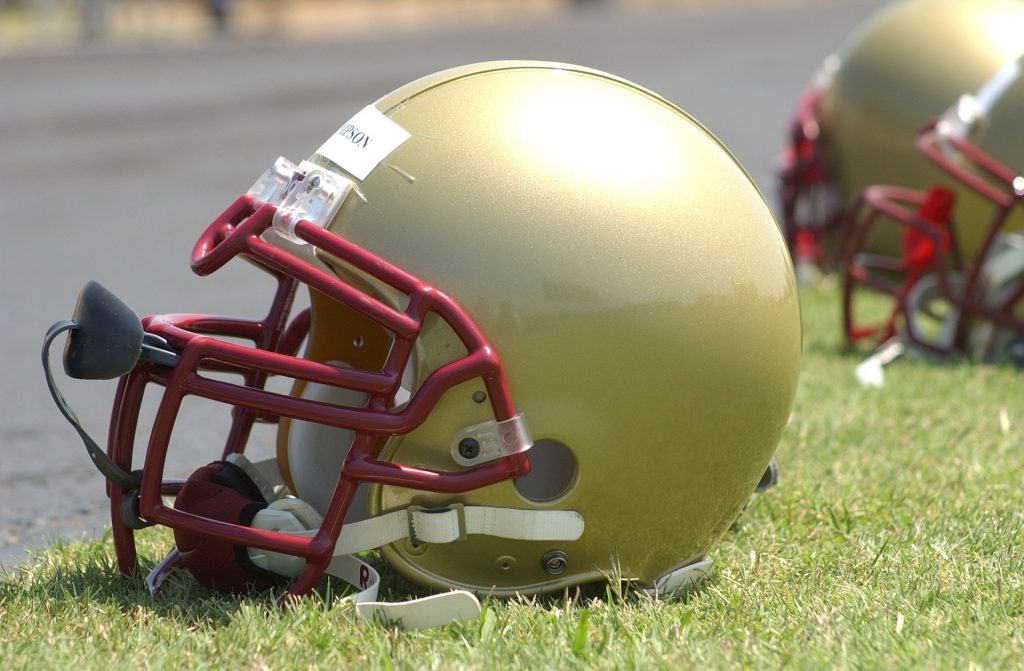Written by Sowmya Kolluru and Edited by Mehr Bawa

According to the American Association of Neurological Surgeons’ report of the CDC’s data on traumatic brain injury (TBI), approximately 1.7 to 3.8 million TBIs occur in the U.S. annually. Of these injuries, outdoor activities such as athletics constitute 10% [1]. The degree of physical and psychological damage ensuing from TBI is extensive, ranging from comas to apparent post-traumatic amnesia. A 2018 University of California, San Francisco study found that in the last ten years, there has been a 70% increase in emergency visits as a result of TBI [2]. TBI is a major class of injuries faced by many individuals, and these statistics permit an increased understanding of these injuries, especially athletes.
Traumatic brain injury results from a hit to the head that disturbs normal neurological functioning [3]. TBI can be broken down into varying levels of severity: mild, moderate, and severe. In mild TBI, while brain imaging shows no damage to tissue; individuals can face some cognitive shortcomings, including loss of memory, decreased comprehension of surroundings, and loss of concentration, as well as a short period of unconsciousness. For individuals with moderate TBI, unconsciousness can persist between a couple of hours to up to a day. Moreover, brain scans can identify some potential brain damage from moderate TBI, and other impairments in memory, comprehension, behavior, and attention. In cases of severe TBI, unconsciousness may persist for over 24 hours, with cognitive, emotional, and physical impairments mirroring those of moderate TBI [4].
TBI can be visualized using brain imaging methods, such as computed tomography (CT) and magnetic resonance imaging (MRI) scans, as well as blood tests. One less invasive technique that is based on the individual’s responses is the Glasgow Coma Scale, which assesses an individual’s ability to speak, open their eyes, and move. Their performance on these tasks is rated using a number scale, and the sum of the ratings is used to differentiate between mild, moderate, and severe TBI [5].
Many studies have analyzed how different sports affect the incidence of TBI. In assessing the rate of TBI in participants of various sports, researchers from the Boston University School of Medicine highlighted football. In recent years, the average incidence of TBI has been increasing, with 6.2 football-related head injuries, on average per year, that did not fully recover between 2000-2009, as compared to 4.5 in the decade prior [6]. In a similar vein, another study noted that out of 233 football athletes who participated in the 1996-1997 football season, 110 had suffered a concussion, with 34.9% of these 233 athletes having suffered more than one concussion [7]. While different studies have reported varying statistics on the incidence of TBI amongst athletes, it is clear that TBIs have been on an upward trend in recent years, and athletes are especially at risk. Further research into the severity scale of TBI, as well as the development of new techniques to minimize incidence of head injury in sports, is needed to improve injury outcomes in athletes and other individuals suffering from TBI.In addition to the necessary improvement of safety regulations in competitive sports, coaches and team staff should be well educated on what TBI is, its numerous risks, and how to help their athletes. A 2017 study published in The Journal of Head Trauma Rehabilitation noted that even though coaches are right beside players on the field, at times, their insight into TBI is shallow. This study aimed to assess the efficacy of the Head’s Up course, which was created with the mission to provide individuals, including coaches, with the knowledge and tools to keep their athletes safe from TBI. Study participants were tested on their knowledge of TBI before and after taking the course, and the results showed that this course improved understanding of TBI [8]. With the major risks associated with head injury, it is not only imperative to learn about the injury itself, but it is equally important to educate coaches to look after the safety of their team.
References:
- Agarwal, N., Thakkar, R., Than, K.. “Sports-related Head Injury.” American Association of Neurological Surgeons, Accessed 27 Jan. 2021. https://www.aans.org/Patients/Neurosurgical-Conditions-and-Treatments/Sports-related-Head-Injury.
- Hsia, R.Y., Markowitz, A.J., Lin, F., Guo, J., Madhok, D.Y., Manley, G.T. (2018) Ten-year trends in traumatic brain injury: a retrospective cohort study of California emergency department and hospital revisits and readmissions. BJM Open, 8: e022297
- “Traumatic Brain Injury.” Mayo Clinic, Accessed 17 Jan. 2021.https://www.mayoclinic.org/diseases-conditions/traumatic-brain-injury/symptoms-causes/syc- 20378557.
- “Severity of TBI.” Traumatic Brain Injury Resource for Survivors and Caregivers, Northeastern University, 2010, Accessed 27 Jan. 2021. https://bouve.northeastern.edu/nutraumaticbraininjury/what-is-tbi/severity-of-tbi/.
- “How do healthcare providers diagnose traumatic brain injury (TBI)?” Eunice Kennedy Shriver National Institute of Child Health and Human Development, National Institute of Health, Accessed 27 Jan. 2021. https://www.nichd.nih.gov/health/topics/tbi/conditioninfo/diagnose#f2.
- Daneshvar, D.H., Nowinski C.J., McKee, A., Cantu, R.C. (2012) The Epidemiology of Sport-Related Concussion. Clinical Journal of Sport Medicine, 30:1-17.
- Langburt, W., Cohen, B.,Akhthar, N., O’Neil, K., Lee, J.C. (2001) Incidence of Concussion in High School Football Players of Ohio and Pennsylvania. Journal of Child Neurology, 16:83-85.
- Parker E. M., Gilchrist, J., Schuster D., Lee, R., Sarmiento, K. (2017)Reach and Knowledge Change Among Coaches and Other Participants of the Online Course: “Concussion in Sports: What You Need to Know”. The Journal of Head Trauma Rehabilitation, 30: 198-206.
